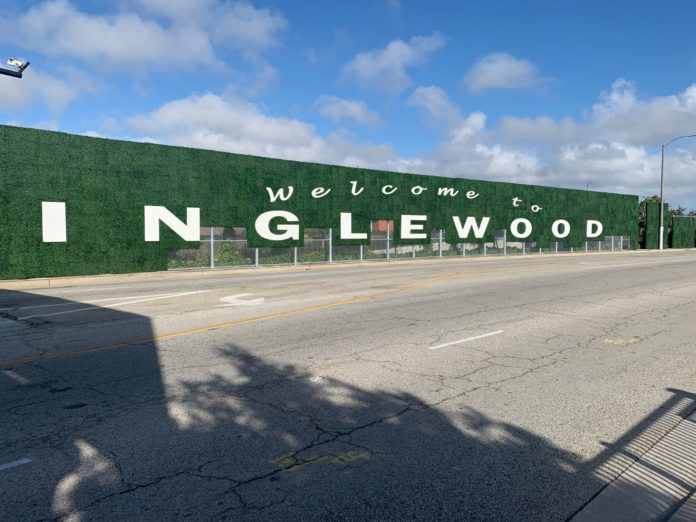Inglewood, California is continuing its top-down led transformation into a redeveloped, cultural epicenter. Under the leadership of its mayor, Inglewood is in the process of re-inventing its reputation as a bustling destination with new and upcoming projects that include the L.A. Clipper’s Intuit Dome, the SoFi Stadium, the YouTube Theater, and the Inglewood Transit Connector. The city’s rising prestige is further reflected through its future role as host to the 2028 Summer Olympics. These emerging developments enhance Inglewood’s property value,
presenting a ripe investment opportunity for developers and builders. Yet, despite the impressive changes that Inglewood has undergone in four years, the city remains susceptible to the detrimental effects of developmental revival. The prices of housing and rent are on the rise, threatening the very community Mayor Butts is purportedly striving to uplift.
Based on 2019 data, the average rent price in Inglewood is $1,357. More than 64% of the 109,613 residents are renters, 57.46% of which experience rent burden. According to the U.S Department of Housing and Urban Development (HUD), rent burden is defined as renters attributing 30% of their income towards housing. Unfortunately, more than one-fifth of the population is considered extremely low-income with 20% existing below the 100 poverty threshold. Approximately 90% of Inglewood residents are black and Latinx compared to Los
Angeles County and California, where white people make up the majority. The ethnic diversity
present in this community which is why gentrification is such a threat. Gentrification is rooted in
racism and essentially makes it difficult for black and brown people to thrive in their communities, economically and culturally. As a result, trends of disenfranchisement and discriminatory practices persist in the process of gentrification.
Indeed, long-time community residents of one of America’s last African American enclaves are experiencing income struggles, scrambling to afford rent, and are at risk for homelessness and extreme poverty. They feel excluded from the city’s forward-moving trajectory. One resident with a two-bedroom apartment next to the SoFi Stadium reports that her monthly rent increased from $1,145 to $2,725. Yet another renter’s monthly rate increased from $1,550 to $2,000 in the span of a year.
Where monthly rental rates are rising to the point of pricing residents out of the neighborhood, increasing housing prices bar potential homeowners from entering the community and preserve the political power and interests of existing homeowners. According to the “home voter” hypothesis, homeowners vote to suppress housing supply to promote higher housing values, maintain traffic levels, or protect the neighborhood’s character. Indeed, Patrick Hutchinson, an Inglewood homeowner who purchased a condo for $80,000, benefits from the
redevelopment of the city. He pays a mortgage rate of $800 per month, but the property is now valued at $520,000. He has expressed looking forward to renting out his condo while living in another state. Concern for how urban redevelopment displaces minority renters is absent.
It seems, then, that promoting home ownership among minority renter residents through a mixture of state-initiated policies presents the best method of promoting local political empowerment and securing community stability. There are four traditional policy approaches that have been used to promote affordable homeownership and reduce displacement in the face of redevelopment: social housing, vouchers, rent control, and governmental regulation of the housing market. However, vouchers are accepted by a limited pool of landholders and are vulnerable to stigmatization and the creation of “ghettos.”
Rent control is a short-term solution that delays the rise of rental prices to market levels and fails to ensure proportional wages that correspond to the market. Social housing and strategic government involvement have produced positive results in the Netherlands and Singapore. The Netherlands have expanded social housing through local home associations and Singapore has utilized its state capacity to reach one of the highest homeownership rates of market economies at 88%.
For some readers, the Netherlands and Singapore offer the aforementioned, generalizable models and methods that we can adopt, customize, and implement in our country: social housing and more governmental regulation of the market. For others who consider the United States unique in its constitution, we can turn to an American initiative. The Federal Housing Administration (FHA) is a federal program that was established in 1934 and promotes
homeownership by offering lower down payment mortgages and a wider array of credit profiles. Here, Inglewood’s leadership can promote homeownership among renters by partnering with counseling agencies, collaborating with FHA-approved lenders, and offering accessible resources that instruct the public on (1) how to become a homeowner and (2) how to be a responsible homeowner.
This article considers Inglewood’s rising housing prices in the context of recent community development projects. As the property value increases, renters of color remain vulnerable to being pushed out of the gentrifying city to its periphery where there is limited access to healthcare, education, and employment. While Inglewood’s mayor has made efforts towards rent control and vouchers, it would be worthwhile to pursue one of the following measures: (1) strengthen social housing by expanding subsidized housing programs, (2) regulate and strategically intervene in the housing market, or (3) partner with the FHA to provide instruction on becoming and being a homeowner. In writing this article, we hope Inglewood’s formal leaders would rise up to protect the interests of historically disadvantaged communities while engaging in community development.
Researched and Written by









